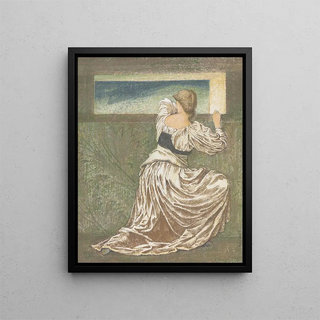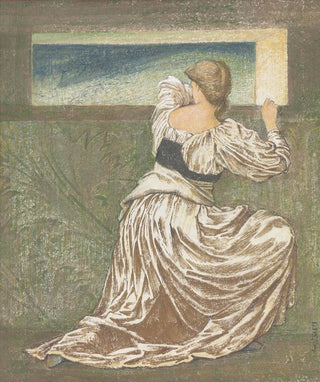Art print | Dorigène of Brittany waiting for her husband's return - Sir Edward Coley Burne-Jones


View from behind

Frame (optional)
Dorigène of Brittany art print waiting for her husband's return - Sir Edward Coley Burne-Jones – Captivating introduction
In the fascinating world of Pre-Raphaelite art, the "Dorigène of Brittany waiting for her husband's return" art print by Sir Edward Coley Burne-Jones stands out for its narrative depth and enchanting aesthetic. This painting, imbued with melancholy and poetry, transports the viewer to a world where time seems suspended, where every detail tells a story— that of a woman awaiting her beloved. With her gaze lost in the horizon, Dorigène embodies hope and patience, universal themes that resonate across ages. The art invites introspective contemplation, revealing the deepest human emotions.
Style and uniqueness of the work
Burne-Jones's style is characterized by rich chromaticity and meticulous attention to detail. In this piece, he employs soft tones and delicate nuances to create a dreamy, almost surreal atmosphere. The drapery of Dorigène's clothing is rendered with remarkable finesse, emphasizing the grace of her silhouette. The composition is carefully balanced, with each element arranged harmoniously to guide the viewer’s eye. Floral motifs in the background and natural elements such as trees and water enhance the romantic character of the scene. This attention to nature, omnipresent in Burne-Jones's work, underscores the connection between man and his environment, while adding a symbolic dimension to Dorigène's waiting.
The artist and his influence
Sir Edward Coley Burne-Jones, an emblematic figure of the Pre-Raphaelite movement, masterfully blended various influences to create a unique style that continues to inspire contemporary artists. Trained alongside Dante Gabriel Rossetti and William Morris, Burne-Jones developed an artistic approach that favors beauty, mystery, and storytelling. His works, often inspired by mythology, legends, and literature, reflect romantic sensitivity and a desire to transcend reality. Burne-Jones's impact extends far beyond his era, as he paved the way for later movements such as Art Nouveau, integrating

Matte finish

View from behind

Frame (optional)
Dorigène of Brittany art print waiting for her husband's return - Sir Edward Coley Burne-Jones – Captivating introduction
In the fascinating world of Pre-Raphaelite art, the "Dorigène of Brittany waiting for her husband's return" art print by Sir Edward Coley Burne-Jones stands out for its narrative depth and enchanting aesthetic. This painting, imbued with melancholy and poetry, transports the viewer to a world where time seems suspended, where every detail tells a story— that of a woman awaiting her beloved. With her gaze lost in the horizon, Dorigène embodies hope and patience, universal themes that resonate across ages. The art invites introspective contemplation, revealing the deepest human emotions.
Style and uniqueness of the work
Burne-Jones's style is characterized by rich chromaticity and meticulous attention to detail. In this piece, he employs soft tones and delicate nuances to create a dreamy, almost surreal atmosphere. The drapery of Dorigène's clothing is rendered with remarkable finesse, emphasizing the grace of her silhouette. The composition is carefully balanced, with each element arranged harmoniously to guide the viewer’s eye. Floral motifs in the background and natural elements such as trees and water enhance the romantic character of the scene. This attention to nature, omnipresent in Burne-Jones's work, underscores the connection between man and his environment, while adding a symbolic dimension to Dorigène's waiting.
The artist and his influence
Sir Edward Coley Burne-Jones, an emblematic figure of the Pre-Raphaelite movement, masterfully blended various influences to create a unique style that continues to inspire contemporary artists. Trained alongside Dante Gabriel Rossetti and William Morris, Burne-Jones developed an artistic approach that favors beauty, mystery, and storytelling. His works, often inspired by mythology, legends, and literature, reflect romantic sensitivity and a desire to transcend reality. Burne-Jones's impact extends far beyond his era, as he paved the way for later movements such as Art Nouveau, integrating






